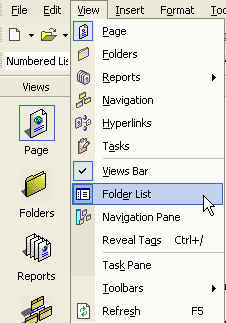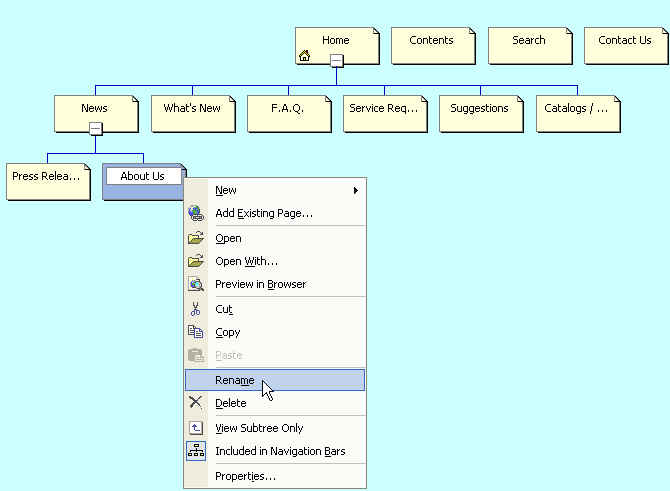FrontPage Help
If you are editing this website with FrontPage, we have made step by step tutorials available so that you can learn how to use FP to build your website.
We STRONGLY suggest taking a look at these tutorials to answer you questions of 'how can I...' before giving us a call. We are happy to answer your questions, but if we feel that the answer to your question can be answered by the tutorials we will direct you back to them. If you would like personal coaching with any of the tools that are used to edit your website we are happy to help; phone calls of a "coaching" nature are billed to your account starting from $1/minute.
General FrontPage Tutorials:
General FrontPage "getting started" skills
- Installing your web site
- Creating a new web site with your new template
- Adding a template page to your new web site
- Removing pages from your web site
- Renaming Pages
- Renaming your menu buttons
- About Cascading Style Sheets (CSS)
- About the Flash animation
- Publishing your web site
Important Points to ease the learning curve
- If you are new to using FrontPage, always have the
"Folder List" turned on, and "View Bars"
so you can easily find the pages and folder in your web
site.
- to turn the folder view on, Click on the View menu,
locate the "Folder List" option, and ensure
the icon is depressed.

- to turn the folder view on, Click on the View menu,
locate the "Folder List" option, and ensure
the icon is depressed.
- FrontPage has an excellent help system built in

Just type in your question to access the help information.
Installing your
web site:
Note: this process only installs the necessary files
to create a web site template, you will need to proceed
to the next step (Creating a new web site) before
you are able to open and edit your web site
- Once you have downloaded your web site, locate the installation file on your hard drive,
- Double click the file to start the installation process. The web site files will be added to your Microsoft office directories, and shared folders. The installation package does not create a directory for your web site. This is done in the next step, Creating a new web site with your new template.
Creating a new web site with your new template
- On the File menu, point
to New, and then click
Page or Web.

- In the New Page or Web task pane, under New from template, click Web Site Templates.
- Click the web site template theme name located in the template window.
- In the Specify the location of the new web box, type the URL for the new web site, or click Browse to create a new site on your hard disk, network, or on the Internet. Mocrosoft recommends creating the web site locally first, then uploading to your server.
- Note To create a subweb, append the name of the subweb to the name of the root web. For example: http://adventure-works.com/subweb.
- Choose one of the following:
- If you want to add the site to the current web site, select Add to current Web.
- If you are creating a Microsoft FrontPage web on a secure port of a Web server that supports Secure Sockets Layer (SSL), select the Secure connection required (SSL) checkbox.
Adding a template page to your new web site
In Page view, do one the following:
Method 1 - Create a page from an existing blank website page:
- In the "File" view, select the file you wish to copy
- On the "Edit" menu select "copy"
- On the "Edit menu select "paste"
Method 2 - Create a page from a blank page (most recommended)
- In the "File" view, select the file you wish to copy
- On the "File" menu select "save as"
- You will be creating a copy of the original, give this copy a name, and click OK
- Your copied page will be added to the folder list
Removing pages from your web site
- Locate the page in your Folder List
- Select the page, and press the delete key on your keyboard.
- You can also delete a web page from the Navigation window, by selecting the page in Navigation view, right click, choose delete, and the second option presented, "delete this page from web".
Renaming Pages
Method one:
- Find the page in your folder list
- Select the page, right click, choose "rename", type in the new name, and then add the extension (.htm)
Method two:
- Click on the Folders icon, from the "Views" menu (right hand side).
- to edit pages located in the root of your web site, click on the top folder (c:\Documents and Settings\.....)
- select the page in the Folders window
- right click, and select "rename"
- press your "tab" key to move the focus to the page "Title" then change the name
Renaming your menu buttons
- Access the Navigation window by clicking on the Navigation
button in the views menu

- Drag your new page into the navigation window, and
drop it to create a "top level" page, or drag it underneath
an existing page to add it to the navigation structure.

- Select the new page, right click on the page title,
and enter the name you would like displayed on for the
menu buttons link

- As in the example above, "About Us" will be displayed as the menu button name. The title of the page in the navigation view does not need to be the same as the name of the page. You could give your page a title such as "About Us" yet, name the htm page "about.htm"
About Cascading Style Sheets (CSS)
All of our templates us Cascading Style Sheets. This helps to conform the text on each page, to be the same. It also sets the size of the text, font style, font type, and color. Using CSS is very important for maintaining the structure of your tables that contain text. What you type into your table and see in your browser, would not always be the same thing that your visitors sees, if it weren't for CSS.
Some additional information on adjusting the CSS in your web site:
- On the View menu, click Folders.
- In the Folders
list, double-click the CSS you want to open.
External style sheets have a .css extension.
- On the Format menu, click Style.
- In the List box, click
the type of style you want to modify.
- To modify a style you've created, click User-defined styles.
- To modify a standard HTML tag, click All HTML tags.
- In the Styles box, double-click the style you want to modify.
- Under Style type,
choose Paragraph
or Character.
Note Some styles may not have this choice.
- Click Format, and
then specify the attributes you want to format:
- To set font properties — such as the font family or color, or character spacing — click Font.
- To set alignment, indentation, or spacing, click Paragraph.
- To set borders and shading, click Border.
- To set the style of bullets and numbering, click Numbering.
- To set positioning properties — such as wrapping style, location, or z-order — click Position.
- Close all dialog boxes to return to the CSS.
Notes
- If you're familiar with CSS syntax, you can edit the text of the CSS directly on the style sheet in Page view.
- This procedure works for both a style sheet you create and for a CSS generated for a theme.
Edit an embedded CSS
About the Flash animation
- The flash animations included with the FrontPage template pages can easily be removed by selecting them while in page view, then pressing the delete key on your keyboard. A background image will be displayed, and you can add text or images into the cell where the flash animation was.
Publishing your Web site
Please check with your ISP to ensure that your hosting plan has the FrontPage extensions, and they are activated. Most web host do, but you need to manually activate them through your web site control panel, usually by logging into your hosting account on-line.
If you are using FrontPage 2002, many hosts are still using FrontPage 2003 server extensions as the default. You will need to ensure that your FrontPage 2002 extensions are enabled if you wish to take advantage of the added benefits of FP2002.
Here is the process involved with publishing your web site:
If your Internet service provider (ISP) has the Microsoft FrontPage Server Extensions or SharePoint Team Services from Microsoft installed, you can publish to the Web server using HTTP. Otherwise, you can use Microsoft FrontPage to publish your web site to an FTP server.
Note If you publish to a location on your local computer, your web site will not have the full FrontPage functionality unless your computer is a server that has the server extensions or SharePoint Team Services installed.
Choose one of the following:
Publish to a Web server (HTTP)
Publish to an FTP server
- On the File menu, click Publish Web.
- In the Publish
Destination dialog box type the location of the
FTP server, or click the arrow to select a location
to which you have already published another web site.
Note If you have previously chosen a publishing destination for this web site, the Publish Destination dialog box will not appear. Proceed to step 4.
- Click OK.
- Specify the pages you want to publish.
How?
- In the Publish Web dialog box, click Options in the lower left corner.
- Click the Publish
tab, and do one or more of the following:
- Under Publish, specify whether you want to publish only pages that have changed, or all pages.
- Under Changes, specify how you want FrontPage to determine which pages have been changed.
- If you want to create a log file for changes made during publishing, select that check box.
- Click OK.
- To publish subwebs, select the Include subwebs check box.
- Click Publish.
FrontPage publishes your web site to the FTP server you specified.
Note If you cancel publishing in the middle of the operation, files that have already been published remain on the destination Web server.
Publish to a location on your local computer
- On the File menu, click Publish Web.
- In the Publish
Destination dialog box, do one of the following:
- Type the path — for example C:\My Website — to the folder on your file system.
- Click Browse to locate the folder.
Note If you have previously chosen a publish destination for this web site, the Publish Destination dialog box will not appear. Proceed to step 4.
- Click OK.
- Specify the pages you want to publish.
How?
- In the Publish Web dialog box, click Options in the lower left corner.
- Click the Publish
tab, and do one or more of the following:
- Under Publish, specify whether you want to publish only pages that have changed, or all pages.
- Under Changes, specify how you want FrontPage to determine which pages have been changed.
- If you want to create a log file for changes made during publishing, select that check box.
- Click OK.
- To publish subwebs, select the Include subwebs check box.
- Click Publish.
Note If you cancel publishing in the middle of the operation, files that have already been published remain on the destination folder.